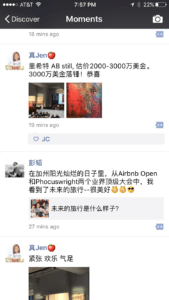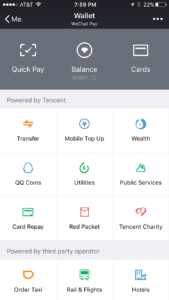Wechat – Cleaning up your mobile screen

If you get Wechat, you get 50% of modern Chinese digital life.
Chinese students coming to the United States experience a certain culture shock on their mobile phone screens. Whatsapp, Groupme, Paypal, Venmo, Skype, Facebook, Facebook Messenger…The sheer number of apps – often with overlapping functionalities – which one needs in order to properly socialize here can be extremely confusing, especially when all of this, and much more, is done within one app only in China: Wechat.
With a staggering user base of around 850 million monthly active users (+30% yoy), Wechat has helped its owner Tencent become an internet powerhouse that’s worth close to $250 billion US dollars in market capitalization. The app permeates all aspects of Chinese life in the digital age, and is a key “gateway app” on any Chinese mobile screen. This means that beyond its own native functionalities, it also acts as a traffic gateway/source for all other apps trying to tap into its vast user base.
Wechat as a Messenger
Wechat started out as a mobile chat app. Today, for social messenging, Wechat has almost entirely replaced traditional texts. Not only is it used for point to point messages between individuals, but group chats are easily formed within Wechat, eliminating the acrobatics of juggling between Facebook Messenger, Whatsapp, Groupme, Snapchat and Skype that one often needs to perform in the US.
As an example of how easily group functions are built in to the app, a speaker at a consumer conference I attended this summer once shouted out a code of “1345” to an audience of several hundreds of people, everyone typed in the code on his or her wechat, and within seconds everyone was in the same wechat group. No email links, no phone numbers – everything instantaneous.
Wechat as a Social Network
As Wechat evolved, it soon evolved beyond a simple messenging to a broader social network app. “Wechat moments”, similar to a Facebook Feed, has essentially replicated the Facebook experience on mobile and is a simple “tab” away from the messenger function within Wechat. Unable to compete with Wechat’s massive scale, most Facebook-equivalent companies in China are now close to bankruptcy.
Wechat has also incorporated more public elements into its social network. In addition to seeing your friends’ Wechat moments, one can also create and follow public accounts, ranging from KOL’s opinion pieces to newspaper articles to the latest and greatest activities available in your local town.
Wechat as a Payment System
Wechat pay – similar to Venmo/Paypal – also allows people to easily transfer money to each other. While this can happen between friends through the traditional messenging interface, through a simple swipe of a QR code money can be transferred to any street merchant without connecting as friends on wechat. In first tier cities like Beijing, Wechat payment is widely accepted, so that on most days consumers can now use Wechat payment almost as a complete substitute for cash. One can even pay for mobile top ups, utilities and a range other services quickly and easily within Wechat Pay.
Wechat as a gateway app
With its vast captive and sticky user base, Wechat has also begun to direct traffic to other key apps users commonly require, in some cases allowing users to access those apps without actually having to download a separate app. For instance, as a substantial equity owner of Didi, China’s equivalent of Uber, as well as Jingdong, China’s equivalent of Amazon, Tencent leverages these resources to allow its users to order Taxis and purchase goods without having to leave the Wechat interface for a separate app.
Going forward – Where are the limits?
While Tencent has been continuously enabling its app with more functionalities, at some point it has to weigh the costs of convenience against the danger that Wechat becomes overly crowded and packed. In my mind, the messenging and social network functions remain key here – focusing on these two aspects and protecting them from getting “squeezed” by other less important functionalities is critical to maintaining healthy usage and traffic to the app. Advertising on “Wechat Moments” will likely remain the key source of revenue for the app, so ensuring value proposition remains strong in this segment of the app is of particular importance. The other functions can then be added on, and given relatively little screen space as “optional” functionalities. In other words, the main presentation should be a one-pager – the rest can go into a useful catalogue of appendices.
Sources:
http://www.tencent.com/en-us/content/ir/fs/attachments/InvestorPresentation2.pdf
Tencent 2015 Annual Report
Word Count: 742 Words





This is fascinating! While we have 100 different apps on our phones, WeChat could substitute all of them together! I am surprized this is not the case yet in US or Europe, but potential answer to it could lie in its nature. From what I understand, WeChat is almost a monopoly. It resembles a system, which is tied to many other apps and creates dependency of both consumers and suppliers. While ultimately convenient, this platform does not have a proper competition, hence, can introduce any ‘rules of the game’ that are most beneficial for the WeChat business rather than for the consumer. Does Chinese government offer any anti-trust regulations in this industry? What if WeChat decides to earn additional revenue by charging subscription fee to both consumers and suppliers? Are there any market forces that could prevent it from charging extra high fees at all?
Haibo, I visited China on a consulting trip earlier this year and was very impressed by WeChat. Iryna notes an interesting point here about WeChat as monopoly. I worry about the same issue, but less from the consumer protection side of things and more on how that monopoly position will affect the growth in additional innovations. While our fragmented app landscape in the US is frustrating in the short-term for the end-user, it rewards the best innovations as consumers can switch their P2P payments app without also switching their messaging app. It seems to me that WeChat’s major innovation is not any particular feature (most of which existed in other markets prior to being brought to China by Tencent), but rather their ability to a) wrap existing features in a single app, and b) deliver that app to a huge Chinese market. In the long term I worry that without healthy competition, WeChat will be a “me-too” developer.
Haibo, thanks for sharing how WeChat have changed our daily life in China. I totally agree with you that WeChat should keep its messaging and social network function as key, as it paves a solid and unparalleled foundation for them to access a large amount of customer and later connect them with “everything”. As a customer, WeChat is my most frequent used App on mobile phone, and it really changes my behavior and makes my daily life easier. For example, customers in some cities now can use WeChat to make appointment with doctors and thus reduce waiting time. The potential of WeChat could even beyond imagination: as Tencent is investing in many different areas in China and overseas and is also collaborating with government, the functions of this single APP could have huge potential, making our daily life much easier and smarter.
Haibo – I’m glad that you raised WeChat; it’s very important to how we should understand the evolution of “digital” life throughout the world. While WhatsApp may still have a larger user base globally (I think they announced 1 billion users back in February?), WeChat’s level of engagement and its ability to serve as a portal for payments, eCommerce, and digital gaming is particularly impressive!
I wonder — do you think that the “WeChat model” will work outside of China?
I’m reminded that in the U.S. much of the electricity distribution infrastructure is still based on wooden utility poles along the sides of roads that were originally invented in the mid-19th century. There’s certainly inertia to certain ways of doing things. By contrast, I sent my first Venmo payment through iMessage yesterday evening. It was remarkably easy — instead of going to the Venmo application, searching for the individual’s user name, confirming their identity, and only then sending the payment — I was able to send the payment based on their phone number. Plus, that payment is in the middle of our message thread (so we have a good record!). Perhaps the app-in-app hybrid approach that iMessage has recently rolled out could be successful? What do you think?
Very interesting post Haibo. It is curious to consider how different app markets are across countries and continents. I am also impressed on how could a single company manage to create an app that provides so many different services. While this app must represent a gold mine for Tencent in the Chinese market, I wonder whether they have the capability to expand beyond China. If the company were to aim for such a pursuit, I would have two concerns. First relates to the fact that each market has its peculiarities and as such the WeChat app with all its various features might need to be adjusted to embrace local market needs. I wonder if Tencent has the capability to undertake such a complicated and complicated task. Second, how will such an app be able to compete with the likes of Facebook and Skype while creating the best products?